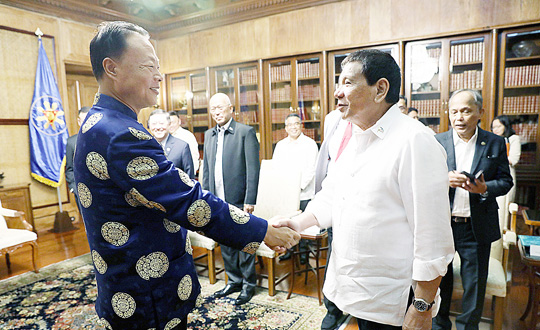
The Philippines will not take part in naval drills with the US after China complained they would clash with President Xi Jinping’s visit to Manila.
Presidential spokesman Harry Roque revealed today (Tuesday, October 9) that the decision to pull out of next month’s drills was agreed when President Duterte met with Chinese Ambassador Zhao Jianhua at the Malacañan yesterday.
“China expressed concern over a naval… a military exercise that the United States will be conducting in the area at about the same time that the Chinese President will be in the Philippines,” Roque told reporters.
“The president said that we will not take part in that military exercise.”
However, military sources have said that there were no naval drills with the US scheduled for next month.
On the other hand, as we reported yesterday, the Philippines has agreed to take part in Chinese naval drills later this month, alongside other members of the Association of Southeast Asian Nations.
And currently, US and Philippe forces are taking part in the Kaagapay ng mga Mandirigma ng Dagat or KAMANDAG exercise, which is set to end tomorrow. The drill involved 1,000 Filipino and American troops, along with a contingent of Japanese servicemen.
Roque also said today that the Philippines and China had agreed that joint oil and gas exploration in the West Philippine Sea would be beneficial to both countries.
“Both agreed that joint exploration in the West Philippine Sea would be to both countries’ interest,” he said, without giving any further details.
“China reiterated that they do not desire any military confrontation as a result of the West Philippine Sea, either with any of the claimant states or with any other countries,” he added.
The West Philippine Sea is that part of the South China Sea that falls within the Philippines’ exclusive economic zone (EEZ), which is 200 nautical miles of territorial waters.
China claims almost all of the South China Sea, but this was rejected by the UN’s Permanent Court of Arbitration in July 2016 after a complaint by the Philippines.
The Hague decision also declared that the Spratly Islands, as well as the Panganiban (Mischief) Reef, Ayungin (Second Thomas) Shoal and Recto (Reed) Bank are all within the EEZ of the Philippines.
President Duterte has set aside this legal victory and has pushed for a joint exploration deal with China even if the 1987 Constitution provides that the exploration, development, and utilisation of natural resources should be under the full control and supervision of the Philippine government.
The constitution also allows the Philippine government to enter into a co-production, joint venture, or production-sharing agreements, but only with private companies 60 per cent owned by Filipino citizens.
Follow our Facebook page for daily news updates
…

Comments are closed.